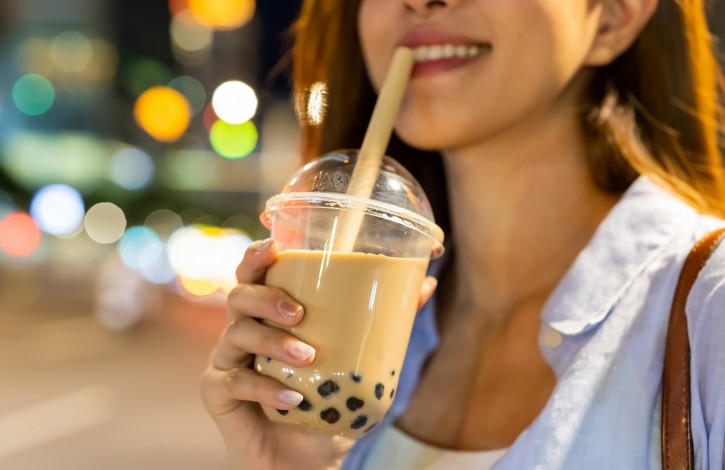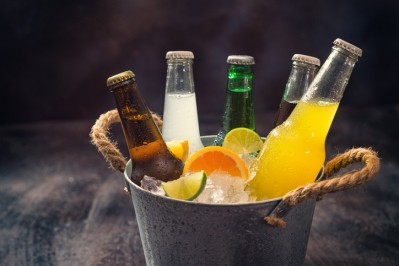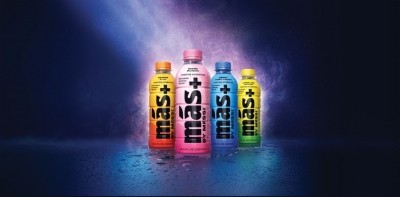Why is bubble tea bubbling up as a popular drink?

Bubble tea – or boba tea - originated in Taiwan in the early 1980s.
And it can embrace all sorts of ideas and concepts. The base of the product is that it’s a tea-based drink: but the name encompasses a broadening range of styles and ideas. It can be accompanied by chewy tapioca balls, or with seaweed-based balls filled with fruit juice. It can come either with or without milk; and use a variety of different teas as their base. It is usually served cold.
The drink is commonly served in transparent plastic dome cups for visual effect; with a fat straw so that, as the drink is sipped, the balls come up with the liquid.
It’s been a firm favorite in Asia for decades, but recent years have seen its popularity spread further afield. In fact, Europe and North America now collectively account for 41% of tea and RTD tea launches with boba in 2023, up from just 12% five years ago, according to data from Mintel.
That success comes from a winning combination of several factors: such as the fun, interactive experience of the balls (or 'bobas', which is where this name comes from).
Then there’s also the visually appealing aesthetics of the drink, as it’s often served in vibrant colors and packaged in aesthetically pleasing ways.
“Bubble tea, also known as a boba or pearl milk tea, originates from east Asia, but in recent years has gained popularity in western markets, including the UK,” Tan Heng Hong, Mintel APAC Senior Food & Drink analyst, told us.
“Social media plays a significant role in boosting bubble tea’s appeal – especially among younger consumers.
“There is also demand for creative bubble tea recipes and international flavors among young consumers.”
Sarah Segal, from North American specialty tea retailer DAVIDsTEA, agrees. The company recently launched a DIY boba kit to make the most of the growing trend.
“First, we have to acknowledge the variety of delicious flavors available, which certainly appeals to a wide demographic," she said.
"We also think this surge in popularity is likely due to its customizable, social media-friendly nature and how seamlessly it lends itself to affordable indulgences and our inherent need to treat ourselves with delicious drinks! What more could you ask for?”
Flavor explosion
“Classic flavors like black tea, green tea, and milk tea remain popular choices in boba tea, as they provide a balanced base that complements the tapioca pearls well,” said Balaji Krishnan, CEO and founder of Frazy, a beverage company which launched its first boba tea in retail August.
“Fruit flavors such as mango, strawberry, and lychee are also highly favored, adding a refreshing twist to the traditional tea base.
“Additionally, trendy flavors like matcha, taro, and brown sugar have gained traction, aligning with broader trends in the beverage category that emphasize unique tastes. These flavors work particularly well with the style of boba tea because they offer a satisfying blend of sweetness and complexity that enhances the overall drinking experience.”
A format just for cafes - or retail as well?
Bubble tea is mainly found in cafés and foodservice venues. But it's making its way into retail in two main types: RTD versions, and then DIY kits that let consumers make their boba tea in a fresh and customized format.
While keeping the texture and mouthfeel of the balls (either tapioca or fruit) over long periods of time could be expected to be a challenge, that’s something that brands are already overcoming.
“While maintaining the freshness and texture of tapioca pearls can be a challenge for some, at Frazy, we have pearls that can be stored at room temperature and microwaved to achieve the perfect consistency,” said CEO Balaji Krishnan.
“The primary challenge with ready-to-drink boba teas lies in keeping the milk fresh over an extended period. If the milk is already in the drink and not in a kit, then it must be kept refrigerated to stay fresh.”
Frazy Boba Tea offers consumers 2.75oz concentrated, shelf stable varieties of boba teas.
Consumers can simply add water to the concentrated boba tea in the Frazy bottle for a drink suited to at home or on the go consumption.
The drinks come with vacuum-sealed packets of boba tapioca pearls and milk powder (if desired). Consumers select and order the type of boba tea they want, the caffeine level, the type of milk (whole, oat, soy, non-dairy creamer, non-fat milk, no milk), sweetness level (sugar, low sugar, no sugar, etc.), and anything else that makes it uniquely theirs.
Each element can be customized, selected, ordered online and delivered to the door - even with a personalized name on the final product.
And that’s where the advantages of kits really stands out, said Krishnan. “The preference for boba kits also reflects a broader consumer trend towards customization and the enjoyment of the preparation process.
"Many consumers appreciate the ability to create their own drinks at home, tailoring each component to their specific tastes.
"This DIY approach ensures that each cup of boba tea is fresh and made to their liking and also adds a fun and interactive element to the experience.”
For RTD, teas without milk pose less of a challenge: opening up a clear way to put bubble tea into the shopping aisle.
For DAVIDsTEA, the point of difference in the retail category has been about turning to its specialty tea USP: using real loose leaf tea with its boba tea kit.
"Customers are loving how simple it is to prepare, and they're especially appreciative of the fact that it's made with real loose leaf tea—not the usual powders or syrups that are typical in this category," said Segal of DAVIDsTEA. "Plus, we included pre-portioned tapioca pearls, which is something we found to be an often-daunting aspect of making at-home boba."
Widening the reach
Packaged bubble tea and RTD bubble tea has potential to take off as a standalone category, confirms Mintel's analysis.
But there's still challenges to address. The high sugar content of many bubble teas found in cafes is accepted by many as an indulgent treat: but it represents a seeds of a potential backlash for the category (Research in Singapore, commissioned by Channel NewsAsia and conducted by students enrolled in the Applied Food Science and Nutrition diploma course at Temasek Polytechnic, found that a 500ml cup of brown sugar boba milk can contain about 92g of sugar: some three times more than the amount of sugar in a 320ml can of cola).
And consumers may be less keen to accept this in the off-trade, where they're less likely to make a spontaneous luxury purchase.
Tan Heng Hong of Mintel adds that, for the category to succeed off-trade as a long-term proposition, it needs to expand usages and find new opportunities to keep consumers engaged in the category.
For example, consumers usually turn to the drink in summer: but making seasonal-inspired drinks (for autumn, Hallowe’en or Christmas, for example) could help extend their appeal. Or simply encouraging consumers to try the drink warm could create an easy winter warmer.
“To increase its appeal in the northern hemisphere, brands are capturing interest by offering warm boba tea drinks during cold months and introducing seasonally inspired drinks to increase the year-round appeal of ready-to-drink (RTD) boba tea," he said.













